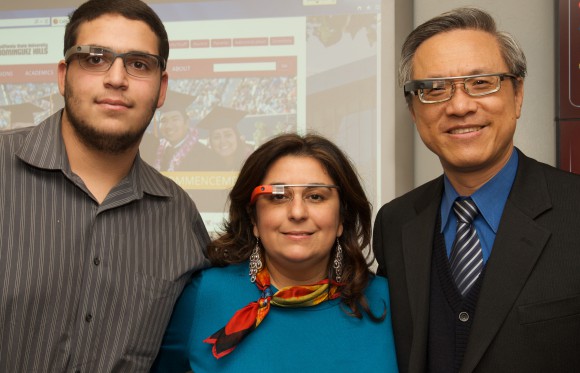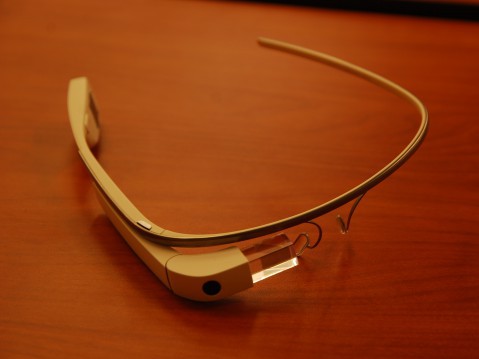As its faculty and students literally gaze into the future, California State University, Dominguez Hills (CSUDH) will be among the first universities in the nation testing Google Glass as a wearable technology that may enhance student learning. The university will be the first in the U.S. to test the device on a large scale in an academic setting.

David Zakariaie, founder and CEO of Glassic, a company that creates industry-specific platforms for Google Glass, met with College of Business Administration and Public Policy (CBAPP) Dean Joseph Wen and faculty chairs on Sept. 11 to demonstrate Google Glass, field questions about the technology, and discuss classroom applications.
The meeting took place in the university’s Financial Market Trading and Business Simulation Lab, the same venue Zakariaie first demonstrated Google Glass for students and faculty as one of a series of presentations hosted by the Hospitality Technology Research Institute (HTRI) in February 2014.
“This wearable technology could become a very useful tool for supporting student learning,” said Wen. “The CBAPP Chairs Council believes the technology may improve small group collaborations, enhance the quality of virtual office hours, collect real-time feedback on student learning, and allow students to stay engaged in class.”
Wen and the Chairs Council approved developing the Google Glass pilot program, which is tentatively scheduled to begin in spring 2015. CSUDH President Willie J. Hagan gave the final stamp of approval to move forward.
The university has already purchased 20 pairs of the device to be tested by CBAPP faculty and students. Once the college determines which professors will be using Google Glass and for what it will be used for, Glassic will propose a few ways Google Glass may be used at CSUDH in academic settings.
The CBAPP brainstormed a variety of ways Google Glass could be utilized in the classroom by students and professors. They include:
- Remote teaching and one-on-one sessions
- Retina scan to help professors identify students who are taking exams
- Accessibility for students and professors with visual, auditory and physical handicaps
- Virtual faculty office hours for students taking online courses
- Audio messages with video that is sent by professors to students while they evaluate their work
- Recording lectures in real-time
- Webinars and online lectures streamed directly on Google Glass
 “It will be exciting to use Google Glass when I have student work that involves groups on assignment, such as mock performance reviews and negotiations. The students will be able to rate their performance and upload the video to a private YouTube channel for later viewing. I expect this will really help them improve their interpersonal and verbal skills,” said Associate Professor Thomas Norman, chair of CBAPP’s Department of Management and Marketing. “Another project could be a mock-interviewing session that our students provide for the students of the Southern California Regional Occupational Center. And there will be many other uses that will emerge, such as the ability to poll students in class.”
“It will be exciting to use Google Glass when I have student work that involves groups on assignment, such as mock performance reviews and negotiations. The students will be able to rate their performance and upload the video to a private YouTube channel for later viewing. I expect this will really help them improve their interpersonal and verbal skills,” said Associate Professor Thomas Norman, chair of CBAPP’s Department of Management and Marketing. “Another project could be a mock-interviewing session that our students provide for the students of the Southern California Regional Occupational Center. And there will be many other uses that will emerge, such as the ability to poll students in class.”
Associate Professor of Marketing Natasa Christodoulidou, who is also director of the HTRI, believes the Google Glass program is a major step for CSUDH in regards to building its reputation in technical research and within industry.
“As the first university in the United States to officially be testing Google Glass in the classroom, I believe we are about to make history. Opportunities such as this only arise once in a lifetime and we are very fortunate to be in the right place at the right time to make this happen,” she said. “… We [as a university] are going to be a test product leader and a pioneer in helping develop a revolutionary relationship with, and linkage between, technology and education.”